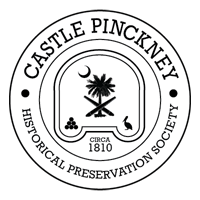Articles, Books and More …
Many articles on Castle Pinckney have been written over the years. In 2024, the first book on the subject was published. Over the years, television stations have broadcast interesting episodes on Castle Pinckney. Recently, several cool YouTube videos on the fort have been posted.
Here, in this website’s Archives, the Castle Pinckney Historical Preservation Society will identify practically anything worthwhile that has been written, broadcast or posted on Castle Pinckney.
“Castle Pinckney: Silent Sentinel in Charleston Harbor”
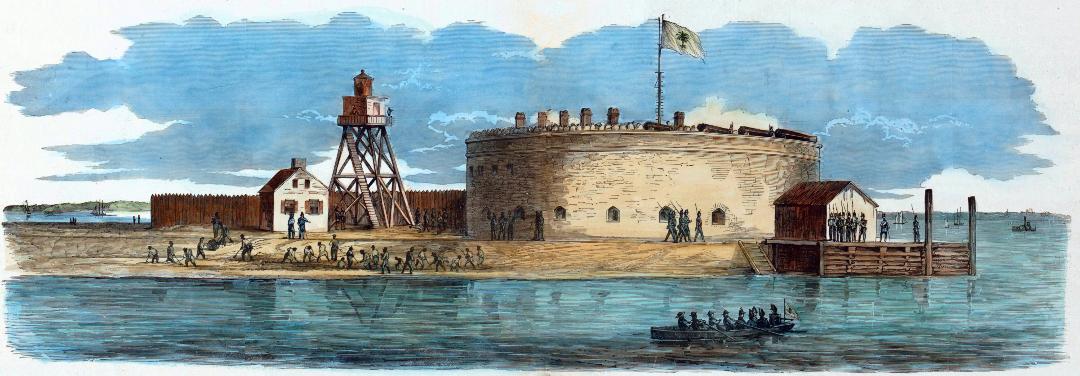
Engraving from a sketch by William Waud (1832-1878) published in Harper’s Weekly on Jan. 26, 1861, and then colored.
(Courtesy of the NYPL Digital Collections)
By Suzannah Smith Miles
The Post & Courier, Moultrie News
Nov. 27, 2012, Updated Aug. 20, 2020
Reprinted with Permission
It is the “other” island in Charleston harbor, the one closest to peninsula Charleston and easily seen from the Battery, often mistaken by visitors for Fort Sumter. Although not much remains of Castle Pinckney proper and its thick brick walls are now crumbling amidst a tangle of wild vegetation, the site has a long and impressive history. More
Fourteen Historic Facts about Castle Pinckney
1). Castle Pinckney was constructed as a state-of-the-art seacoast fortress on the eve of the War of 1812.
2). The masonry fort, with its innovative horseshoe design, was part of the nation’s “second system” of coastal fortifications.
3). The structure was built on Shute’s Folly, a marshy island in the center of Charleston Harbor, and designed to protect Charleston from a naval attack.
4). Castle Pinckney’s strategic location allowed the fort to command Charleston and the busy wharves along East Bay Street facing the Cooper River. This made the fort an important chess piece in the secession turmoil of 1832 and 1850, and in the months leading up to the bombardment of Fort Sumter on Apr. 12, 1861.
5). Famous leaders – including President James Monroe and Generals Winfield Scott, Robert E. Lee and P.G.T. Beauregard – inspected its casements and barracks.
6). Defending the fort was one of Gen. Winfield Scott’s major concerns during the Nullification Crisis of 1832.
7). Seminole Indians and Africans from the illegal slave ship Echo were held there.
8). In 1860, Maj. Robert Anderson – the Hero of Fort Sumter – requested more Federal troops to hold Castle Pinckney because he believed the fort was the key to protecting his small force at Fort Moultrie.
9). In December 1860, three companies of Charleston Militia scaled Castle Pinckney’s walls and seized the fort in a daring act that pushed the United States to the edge of Civil War.
10). After the Battle of First Manassas (First Battle of Bull Run), 156 captured Federal officers and enlisted men were held at the fort.
11). In 1863, members of the famous 54th Massachusetts Infantry Regiment – featured in the movie, “Glory” (1989) – were held at Castle Pinckney.
12). By 1865, the old fort was transformed into an earthen barbette battery with a Brooke Rifle and three giant 10-inch Columbiads.
13). During Reconstruction after the Civil War, Castle Pinckney became an “American Bastille” for Southerners accused of crimes against the government.
14). The structure finished its days of active service as a supply depot for all coastal lighthouses from North Carolina to Florida.
YouTube Tour of Castle Pinckney, led by Co-Authors of New Book
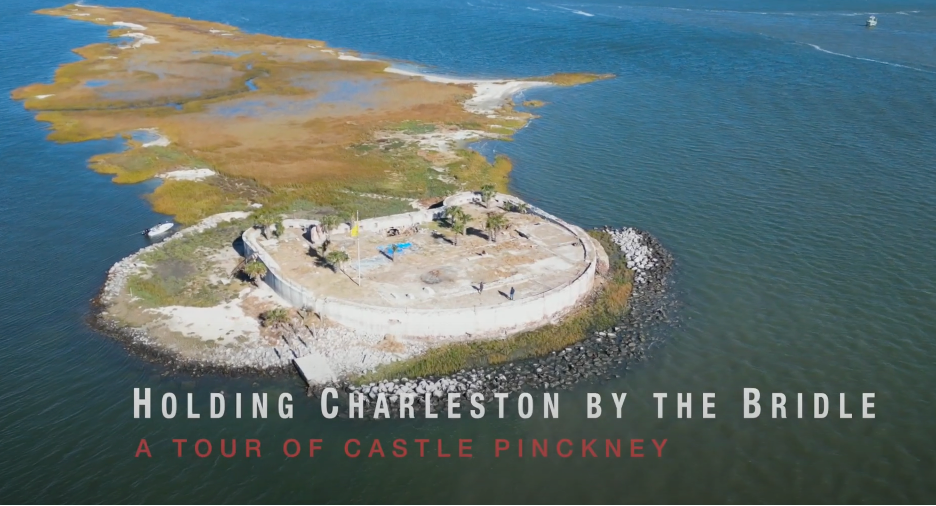
Co-authors Holding Charleston by the Bridle: Castle Pinckney and the Civil War (2024), W. Clifford Roberts, Jr. and Matthew A.M. Locke, serve as tour guides in this new YouTube video of Castle Pinckney. The book’s co-authors lead viewers on a tour of the historic fort in Charleston Harbor, showing details of the structure’s interior and exterior. They explain the fort’s history, from the War of the American Revolution to the Civil War, and the challenges of protecting the historic brick and mortar fort. Courtesy of Rob Shenk, Wide Awake Films, Mount Pleasant, S.C. Watch Video
Holding CHARLESTON by the Bridle: Castle Pinckney and the Civil War
Holding Charleston by the Bridle: Castle Pinckney and the Civil War, by W. Clifford Roberts, Jr. and Matthew A. M. Locke, is the first book on the subject. The authors, relying on extensive primary research and archaeological evidence, tell the full story of Castle Pinckney. They explain everything, from the fort’s innovative design as part of America’s “Second System” of coastal fortifications to the modern challenges of preserving its weathered brick walls against rising sea levels. Given its importance to America’s history, this book is long overdue. Considering current efforts to protect and restore the historic fort, it is a must-read. For Sale Online
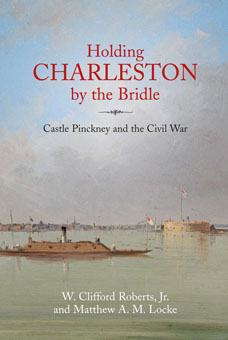
“The Civil War Transformation of Castle Pinckney”
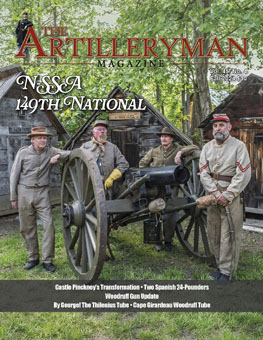
“The Civil War Transformation of Castle Pinckney,” The Artilleryman Magazine, Fall 2024, Vol. 45, No. 4.
W. Clifford Roberts and Matthew A.M. Locke, co-authors of the first book on the fort, Holding CHARLESTON by the Bridle: Castle Pinckney and the Civil War (2024), explain the capture of the Castle Pinckney on Dec. 27, 1861 before the bombardment of Fort Sumter on Apr. 12, 1861, and the fort’s transformation from a brick and mortar structure to an earthenwork battery. They also explain its use as a POW camp after the First Battle of Bull Run and much more. The illustrated article includes many historic photographs. Read Article
The Flags That Flew Over Castle Pinckney: Research, Analysis, Findings, and Recommendations

By Tom Elmore, April 2013. For the best article on the flags that flew over Castle Pinckney from 1818 to 1878 (only 10 shown below), this is a must-read. Read Article
Television Station, WCBD News 2, Broadcasts Piece on Castle Pinckney

A YouTube video was posted after WCBD News 2, a television station in Charleston, S.C., broadcast an interesting piece, “Charleston Unknown History: Castle Pinckney,” on July 7, 2025. Watch Video
Three Cool Historical Visualizations Depict Castle Pinckney on the Eve of the Civil War and during the War

Using historical documents and photos, Salt Marsh Galleries has created three cool historical visualizations of Castle Pickney and combined them into one three-minute-long YouTube video. The visualizations depict the fort as it looked on the eve of the Civil War, as a prisoner of war camp early in the war and as it looked near the end of the war. Watch Video
Castle Pinckney Work Continues: Testing and Monitoring during the Down Season in 2020
By John Fisher, Legacy, S.C. Institute of Archaeology and Anthropology, University of South Carolina Arts and Sciences, Vol. 24, No. 1, September 2020 Read Article
From American Revolution to Civil War: The Fort of Castle Pinckney, Charleston, S.C.
By John Fisher, South Carolina Institute of Archaeology and Anthropology and Giles Dawkes, Archaeology South-East, University College of London, Society for Post-Medieval Archaeology Newsletter, Issue 86, Spring 2020 Read Article
The Mysterious Island Fort in Charleston Harbor: Breaking Ground at Castle Pinckney
By John Fisher, Legacy, S.C. Institute of Archaeology and Anthropology, University of South Carolina Arts and Sciences, Vol. 23, No. 2, December 2019 Read Article
